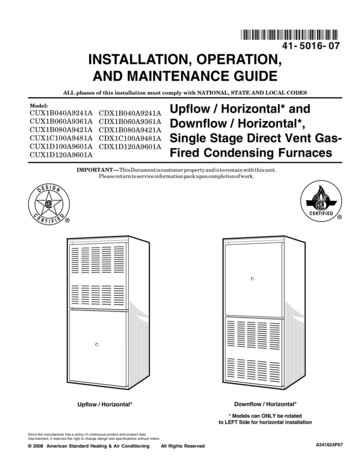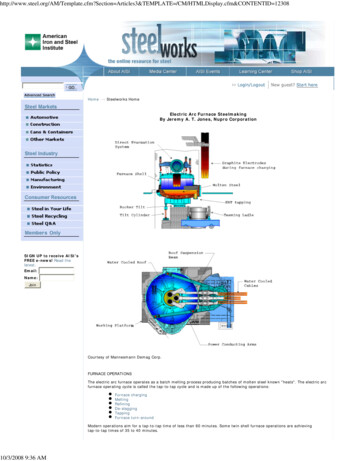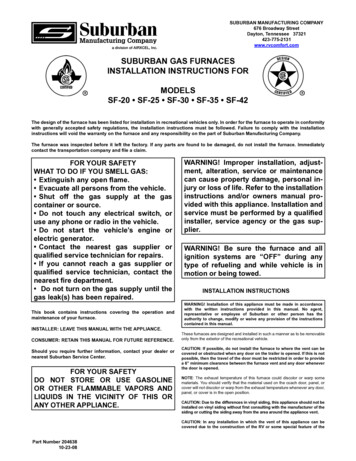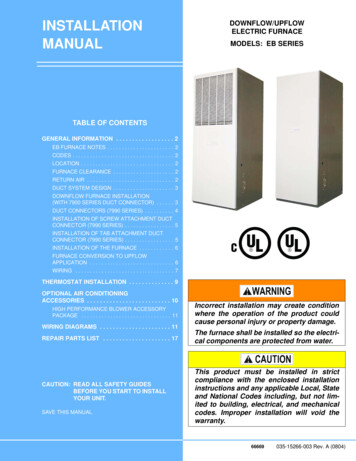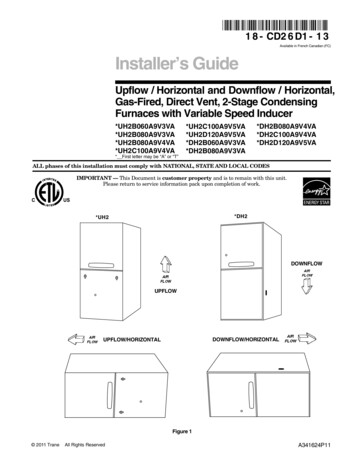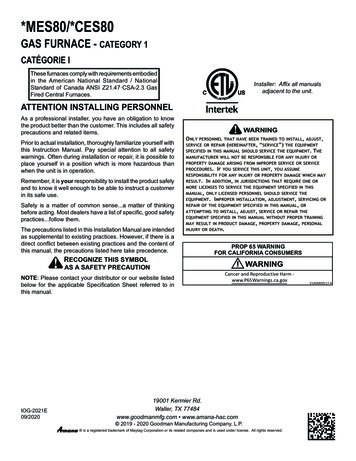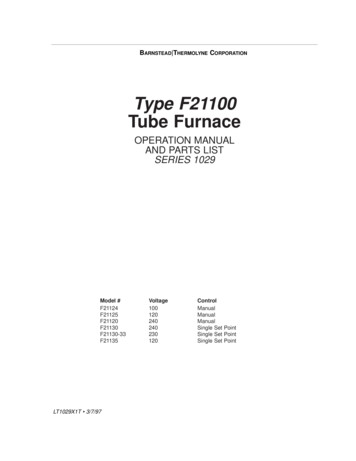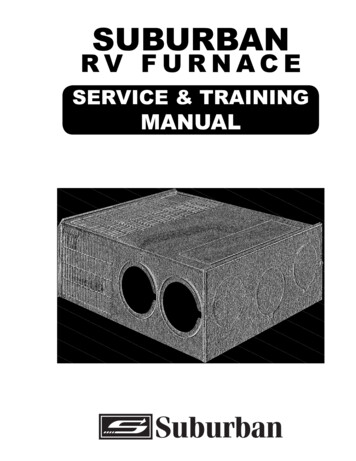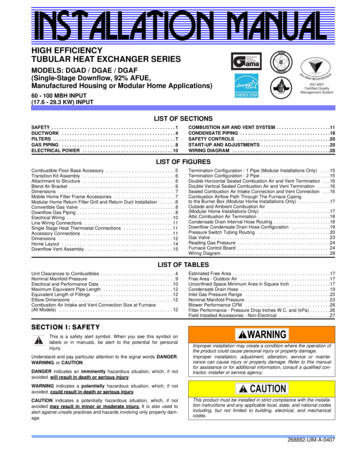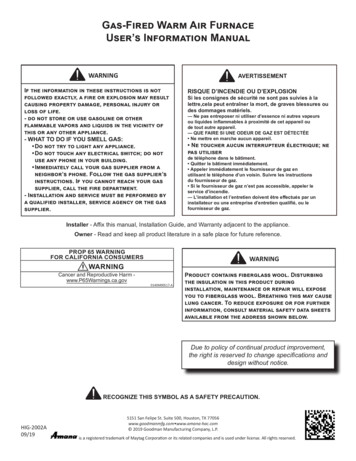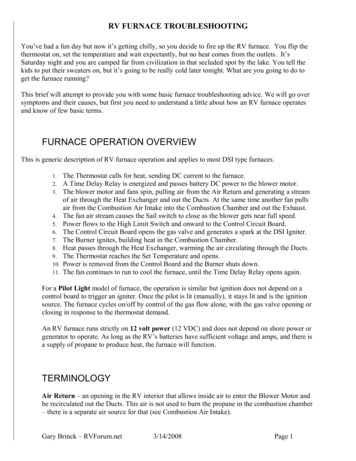
Transcription
RV FURNACE TROUBLESHOOTINGYou’ve had a fun day but now it’s getting chilly, so you decide to fire up the RV furnace. You flip thethermostat on, set the temperature and wait expectantly, but no heat comes from the outlets. It’sSaturday night and you are camped far from civilization in that secluded spot by the lake. You tell thekids to put their sweaters on, but it’s going to be really cold later tonight. What are you going to do toget the furnace running?This brief will attempt to provide you with some basic furnace troubleshooting advice. We will go oversymptoms and their causes, but first you need to understand a little about how an RV furnace operatesand know of few basic terms.FURNACE OPERATION OVERVIEWThis is generic description of RV furnace operation and applies to most DSI type furnaces.1.2.3.4.5.6.7.8.9.10.11.The Thermostat calls for heat, sending DC current to the furnace.A Time Delay Relay is energized and passes battery DC power to the blower motor.The blower motor and fans spin, pulling air from the Air Return and generating a streamof air through the Heat Exchanger and out the Ducts. At the same time another fan pullsair from the Combustion Air Intake into the Combustion Chamber and out the Exhaust.The fan air stream causes the Sail switch to close as the blower gets near full speed.Power flows to the High Limit Switch and onward to the Control Circuit Board.The Control Circuit Board opens the gas valve and generates a spark at the DSI Igniter.The Burner ignites, building heat in the Combustion Chamber.Heat passes through the Heat Exchanger, warming the air circulating through the Ducts.The Thermostat reaches the Set Temperature and opens.Power is removed from the Control Board and the Burner shuts down.The fan continues to run to cool the furnace, until the Time Delay Relay opens again.For a Pilot Light model of furnace, the operation is similar but ignition does not depend on acontrol board to trigger an igniter. Once the pilot is lit (manually), it stays lit and is the ignitionsource. The furnace cycles on/off by control of the gas flow alone, with the gas valve opening orclosing in response to the thermostat demand.An RV furnace runs strictly on 12 volt power (12 VDC) and does not depend on shore power orgenerator to operate. As long as the RV’s batteries have sufficient voltage and amps, and there isa supply of propane to produce heat, the furnace will function.TERMINOLOGYAir Return – an opening in the RV interior that allows inside air to enter the Blower Motor andbe recirculated out the Ducts. This air is not used to burn the propane in the combustion chamber– there is a separate air source for that (see Combustion Air Intake).Gary Brinck – RVForum.net3/14/2008Page 1
RV FURNACE TROUBLESHOOTINGBlower Motor – A 12VDC motor driving a pair of “squirrel cage” fans that circulate air throughthe furnace. One fan brings RV interior air in via the Air Return and through the Heat Exchangerand out the Ducts while the other brings outside air into the combustion chamber and out theexhaust.Circuit Breaker & On/Off SwitchNewer furnaces have an On/Off switch and a Circuit Breaker [CB] in the power feed to theBlower Motor. The switch is for manual control, especially while serving the motor or burner.The Circuit Breaker limits the power to the motor. If the CB has opened, it can be reset but theconditions that caused it to open must be repaired for a lasting fix.Combustion Air Intake – A fan with an air inlet on the exterior of the RV that provides air tothe Combustion Chamber. This air is used when the propane burns.Combustion Chamber – The metal box where propane and air are burned.DSI – is an acronym for Direct Spark Ignition. It refers to the use of an electronic Igniter to firethe propane instead of a pilot light.Ducts – round or rectangular tubes that carry heated air from the furnace to the RV interior.Exhaust – An air outlet on the exterior of the RV that vents exhaust gases, including carbonmonoxide and carbon dioxide, from the Combustion Chamber. Exhaust gas contains carbonmonoxide and carbon dioxide and must never be allowed to enter the interior of the RV. Injuryor death can result if it does!Fan Speed Controller – On models with two or more fan speeds, this small circuit board setsthe motor speed and thus governs the speed of both fans. This also affects the BTU (heat) outputdelivered by the furnace – lower fan speed means lower BTUs and so the Gas Valve opening isalso reduced.Heat Exchanger – A metal box that uses heat conducted from the Combustion Chamber towarm the circulating air.Gas Valve – an electrically operated valve which opens to allow propane to flow into the burnerchamber. It is controlled by the Control Circuit Board.High Limit Switch – a normally closed switch that opens if it gets too hot. Its purpose is tomonitor temperatures in the Heat Exchanger and to prevent overheating that could burn a hole inthe metal. Opening this switch turns off power to the gas valve and the Controller Board,shutting down the furnace. A hole in the Heat Exchanger would allow deadly poisonous gases toenter the RV interior, so this is a crucial safety device.Igniter – An electrical device that generates a spark to ignite the propane. In DSI furnaces, theigniter serves in place of a Pilot Light. In newer furnaces, the igniter also serves as a flamesensor, providing feedback to the Ignition Control Board to verify that ignition was successful.Gary Brinck – RVForum.net3/14/2008Page 2
RV FURNACE TROUBLESHOOTINGIgnition Control Circuit Board – A printed circuit board that initiates gas valve opening andtriggers the Igniter. In some furnaces the Igniter sequence may last several seconds and makemultiple attempts to light the flame. You may hear a tick-tick-tick sound as the Igniter is cycledrepeatedly. Other boards will make three attemptsat approximately 60 second intervals. In oldermodels there is only one attempt to light and thethermostat must be cycled off for several secondsand back on again to initiate another ignitioncycle. In newer furnaces there is a feedback signalfrom the igniter to confirm that ignition wassuccessful and a flame is present. If there is nopositive ignition feedback within 6-10 seconds,the gas supply will be shut off and the furnace is“locked out”. In some furnaces there are twocircuit boards – one for ignition and one for speedcontrol of the blower motorLock-outThe Control (Ignition) Circuit Board is shut down because an unsafe operating condition hasbeen detected.Pilot Light – A tiny propane flame that remains continually on (burning) and lights a largercharge of propane when the main gas valve opens. It is initially lit manually and can remain onas long as the furnace is expected to be needed. Not used in a DSI furnace.Sail Switch - a switch with a paddle arm thatextends into the blower air stream. It closes whenthe blower reaches its rated speed (or nearly so) andallows power to pass to the ignition circuit. This is asafety device to assure there is adequate aircirculation in the furnace.Thermostat – a device that senses temperature in the RV interior and sends a signal to thefurnace when the temperature drops below the “set temperature”, i.e. the temperature you wish tomaintain. This signal is termed “calling for heat or “demanding heat”. When the thermostat is notcalling for heat, it is said to be “satisfied”.Time Delay Relay – A relay (switch) that generates a slighttime delay before the furnace start cycle proceeds. It has aninternal heater that warms up as the current from the thermostatpasses through it and the relay closes when it gets hot enough.Gary Brinck – RVForum.net3/14/2008Page 3
RV FURNACE TROUBLESHOOTINGA delay of about 10-20 seconds is typical. When the relay closes, 12V power from the battery ispassed to the blower motor and the fans start to run.TIPS and TECHNIQUESTools NeededIt is difficult to do much troubleshooting on a furnace without a voltmeter and the basic knowhow to use it. Most tests are voltage measurements to see if adequate power is reaching variouscomponents of the system. If you buy an inexpensive Volt-Ohm Meter (VOM), it will usuallyhave brief instructions with it. You don’t need a fancy one – the measurements used do notrequire a lot of accuracy.Diagnostic Light & CodesNewer Atwood furnaces may have a small red light on the Ignition Control Circuit Board. Thelight will flash a code (typically 1-5 flashes) to indicate error conditions such as High LimitSwitch open. There should be a code chart on the motor housing for that model of furnace.Blower Motor and FansThe fans are behind the outside access cover. The motor has a shaft running through the centerof it with one shaft (usually the left side) driving the main furnace air circulation fan and theother driving the combustion air fan. There are two blowers (fans) but only one motor. Typicallythere is a casing surrounding the motor and the air circulation fan and the Sail Switch may alsobe inside that casing.The motor is powered by the RV’s 12v system and is affected by low voltage. When the batterycharging system is operational (shore power or generator on) the DC voltage usually remainssufficient (12.0 – 13.8VDC), but when relying on battery power alone the voltage drops and mayget quite low overnight. The motor will continue to run at lower voltages (down to around 10.5VDC) but fan speeds may be insufficient to activate the sail switch or provide adequatecombustion air to the burner. Corrosion on the wiring or furnace power terminals may also causereduced voltage at the blower motor. Check the voltage at the motor itself as well as at thebatteries or your RV’s monitoring panel.Combustion Air Intake & ExhaustThe external Combustion Air Intake & Exhaust is through the external furnacecover panel and may be either two ports or a mesh intake grill surrounding asingle exhaust port (illustrated). Bugs such a spiders and mud dauber waspsand even mice may nest inside and block air flow, so check for blockages.Some furnaces do not run well with the cover removed, so it may be necessaryto replace the outside cover for testing.Gary Brinck – RVForum.net3/14/2008Page 4
RV FURNACE TROUBLESHOOTINGAir Return and DuctsReturn air vents should be kept free of dust and lint and should not be obstructed. Vacuum theintake area and screen (and filter, if provided) to keep good air flow through the heat exchangerand to keep dist and dirt from building up around the fans, sail switch, limit switch, exchangerand ducts. Dirt in these places can cause switch malfunctions and internal heat build-up. Crimpsin ducts can also reduce air flow into the room or cause the high limit switch to activate.Lock-out & ResetNewer furnaces may go into “lock-out” if a potential safety problem is detected. Lock-out simplymeans that the Control and/or ignition circuits shut down and do not allow furnace operation.Lock-out can be reset by turning the thermostat switch off and changing the Set Temperature to alow enough value so there is no demand for heat and waiting 10-15 seconds. Then turn thethermostat on and set the temperature to the desired level and the furnace should attempt to startagain.Propane Gas PressureAll propane appliances are designed to operate from a propane (LPG) supply that is at a standardpressure of 11 water column inches of pressure (about 3 psi). This is measured with a tool calleda manometer. The LP tank pressure is much higher than 11” WC, so the pressure in the system iscontrolled by an LP regulator at or near the main supply tank. Either high or low pressure cancause the burner to fail to light or work improperly. Oily residue in the tank can clog theregulator, causing it to deliver gas at an incorrect pressure or sporadically. And of course anempty tank has little or no pressure. An LP regulator is not expensive, so if you suspect aproblem with the gas supply, replacing the regulator is usually more cost effective than hiring aprofessional to test it. LP regulators are standard parts, available at any LP gas dealer and manyhardware and home stores. You do not need an RV specific part, but do not use a regulatorintended for natural gas.SYMPTOMS AND CAUSESFind your symptom below and see what the likely causes may be.Thermostat On but Furnace Fan Does Not Come OnThis may be caused by:1. No voltage from thermostat to furnace (bad wire or no power to thermostat)2. Bad Time Delay Relay3. No 12v power from the battery to the furnace Time Delay RelayGary Brinck – RVForum.net3/14/2008Page 5
RV FURNACE TROUBLESHOOTING4. Motor circuit breaker is open or manual switch is Off5. Loose wire6. Bad blower motorLow battery voltage can cause excessive current through the motor and trip the circuit breakerand so can excessive load on the motor, e.g. dirt in the fan housing. A defective motor can alsocause a breaker to trip.Fan Runs but No Heat from DuctsThis is a classic condition with several possible causes, most of which should be obvious afterreading the Operational Overview.1. The Sail Switch is not closing, so no power to the rest of the furnace. This may be because ofa defective switch or because the fan is turning too slowly to push the sail enough to fullyclose the switch. A slow motor may result from low voltage at the motor (check voltage atbatteries and at the fan) or a motor that is simply not turning well due to dirt or corrosion. Ablockage of the Return Air Intake can also cause a lack of air flow against the Sail.2. The High Limit Switch has failed and is not closed, so no power reaches the ControllerCircuit Board and hence no ignition. Check for 12 volts leaving the switch and/or at theterminal on the controller.3. The Control Circuit Board is failing and either does not open the Gas valve or does nottrigger the Igniter. Check for 12V to the gas valve during the opening cycle.4. The Gas Valve fails to open, so no propane in the burner. Could be a bad valve or simply no12v power is reaching the valve (check voltage).5. The Gas Valve is open but no propane flows. Possible causes include no propane or lowpropane pressure (less than 11 water column inches). Low or no propane can be caused by aclogged line or main propane regulator. Check other propane appliances for proper operation.6. The Igniter fails to spark (or in a non-DSI furnace, the Pilot Light is not on). Could be adefective Igniter or no 12v power is reaching it. It is also possible the gap at the ends of theIgniter electrodes is too great (or that they are shorted together).7. Igniter does not confirm that ignition was successful (no flame is sensed), so theControl/Ignition board has shut down (lock-out)8. Propane and spark are present but the burner doesn’t light. This can occur if the CombustionAir Intake is clogged and there is insufficient air flow through the combustion chamber.9. Loose or corroded connections in any of the above componentsFurnace Runs for One Cycle but Won’t RestartThe typical cause is a blockage in the Combustion Air Intake or Exhaust, resulting in a lack ofair into or out of the combustion chamber. Look for spider webs, dauber nests, debris in the airinlet and exhaust. It may also be caused by an inadequate gas supply, e.g. low gas pressure or apartially open Gas Valve. See Propane Gas Pressure.Gary Brinck – RVForum.net3/14/2008Page 6
RV FURNACE TROUBLESHOOTINGShort Cycling - Furnace Starts and Stops at Short IntervalsThis is usually caused by warmed air from the Ducts blowing out onto the thermostat, causing itto be satisfied, but as soon as the warm air stops flowing the thermostat cools and calls for heatagain. If the Duct outlets are adjustable, try aiming them away from the thermostat or closing thenearest outlet. A cold draft on the thermostat can have the same effect – look for a cold aircurrent leaking in from somewhere. Sometimes an over-sensitive thermostat will also do this andreplacing it will cure the problem.Fans Run and Heat is Produced but Burner Goes Off and OnThis is called “cycling on the limit switch” and results from overheating in the Heat Exchanger,which causes the High Limit Switch to engage. The usual cause for this is poor air circulationthrough the furnace, which is a result of blockage of the Air Return or outlet Ducts. Anaccumulation of dust and dirt in the Heat Exchanger can also cause it. And in rare cases it maybe an over-sensitive limit switch.Furnace Runs Normally but Does Not Shut Off When Temperature is ReachedThis suggests that the thermostat is still calling for heat. Check the voltage on the wire to theTime Delay Relay to see if this is the case. If voltage is present, the thermostat is defective. If novoltage is present, there is a short in the furnace wiring that is creating the voltage that normallycomes from the thermostat. Note, though, that it is normal for the fan to run for 20-60 secondsafter the thermostat is satisfied. This cools the furnace internally.Soot on the outside exhaust ventSoot is a sign of improper combustion and means there is a problem. Carbon monoxide [CO] isanother byproduct of improper combustion and is an extremely dangerous gas, so a furnaceshowing soot at the outside vent should be repaired BEFORE being used again. Soot and COresult from burning the propane without sufficient combustion air and generally means thateither the Combustion Air Intake is blocked or the Intake Blower is running too slowly. SeeBlower Motor and Fans and Combustion Air Intake & Exhaust.Works on Shore Power but Not When DisconnectedGary Brinck – RVForum.net3/14/2008Page 7
RV FURNACE TROUBLESHOOTINGThis is a sign of a weak battery or corrosion between the battery and the furnace, resulting in lowvoltage at the furnace. When on shore power, the charging system keeps the voltage up high andpowers the furnace, but without it the voltage drops low enough that it cannot operate reliably.While the furnace specs may say it will run from 10.5 to 13.8v, in practice the furnace may notstart and run much below 11.5v.Furnace Goes Dead OvernightThis is usually just an exhausted battery. The furnace blower uses a lot of electricity and if theRV’s charging system is not running the battery can easily go dead overnight. May be badbattery(s) or simply insufficient batteries for the amount of power you are consuming. Lowvoltage at the furnace (due to corrosion in the wiring) can contribute to this because the motordraws more current when the voltage is very low (under 12.0 vdc).Fan Motor Makes Screeching NoiseThis is typically caused by the fan blades rubbing against the fan housing in either the twoblowers in the furnace or a bad bearing in the motor. (see Blower Motor and Fans).Poor Air Flow from Duct OutletsThis is often caused by crimped ducts or excessive length ducts that have extra loops that slowdown air flow. Check as much of the ducting as you can reach and straighten loops (removingexcess if possible) and eliminate kinks and crimps as much as possible. Also check the outletsthemselves – many are adjustable and may be partially closed. Take the outlet off and make sureit actually opens – broken ones are not uncommon.Gary Brinck – RVForum.net3/14/2008Page 8
RV FURNACE TROUBLESHOOTINGPHOTOSAtwood Two Speed Furnace (Model 8500-IV)Gary Brinck – RVForum.net3/14/2008Page 9
RV FURNACE TROUBLESHOOTINGOlder Atwood with ported intake & exhaust (circuit board not visible)LINKS FOR MORE HELPAtwood Video - gvid.cfmAtwood Troubleshoot - mMark’s RV - http://www.marksrv.com/furnace trouble shooting.htmDuckTec Parts - mlRVers Corner - V Motorhome Answers - lRx4RVs - http://rx4rv.com/archives/17Gary Brinck – RVForum.net3/14/2008Page 10
RV FURNACE TROUBLESHOOTINGDinosaur Circuit Boards - http://www.dinosaurelectronics.com/SOURCES FOR MANUALSAtwood Parts - cfmBryant RV – Furnace and Refrigerator manuals: http://bryantrv.com/docs.htmlGary Brinck – RVForum.net3/14/2008Page 11
For a Pilot Light model of furnace, the operation is similar but ignition does not depend on a control board to trigger an igniter. Once the pilot is lit (manually), it stays lit and is the ignition source. The furnace cycles on/off by control of the gas flow alone, with the gas valve opening or closing in response to the thermostat demand.


